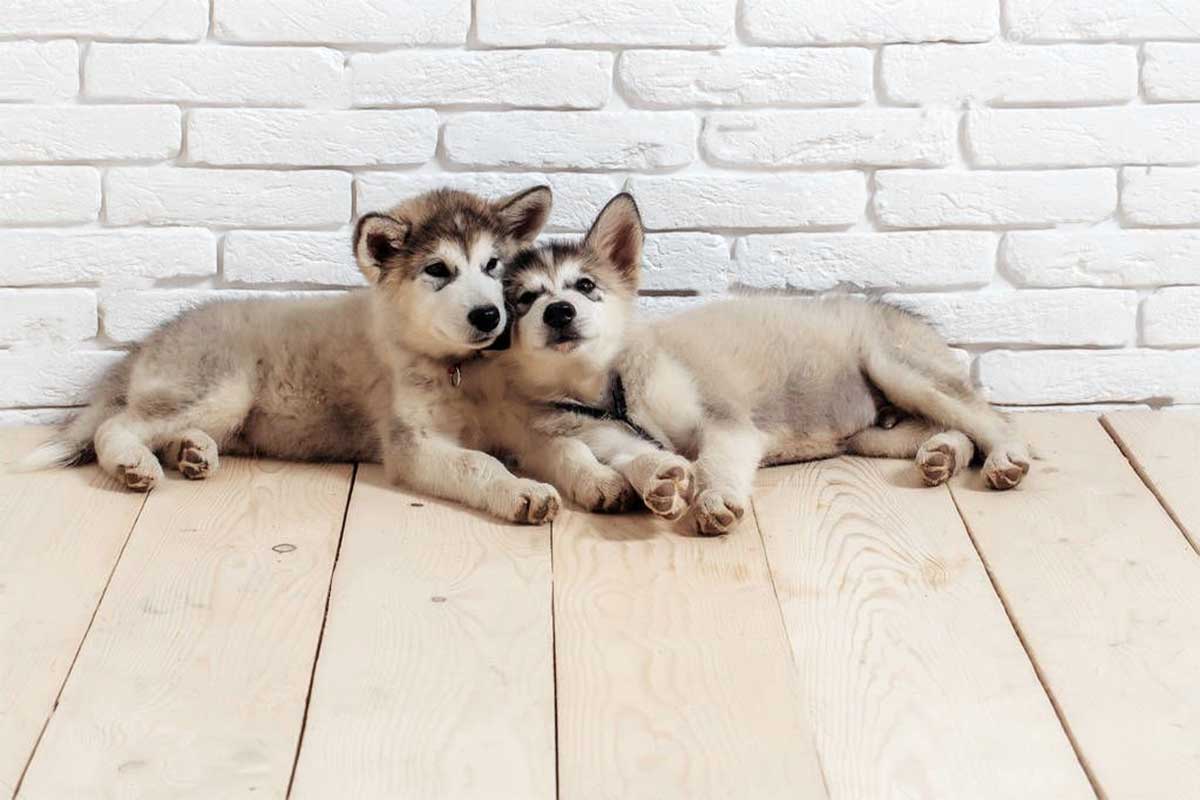I remember bringing our first pair of rescue puppies home and them quickly learning to enjoy chewing on our built in wooden bookshelves.
As first time dog owners we were not sure what to do and you may be experiencing that same feeling right now.
If you are wondering how to stop a dog from chewing on wood, I hope this article helps!
Below you will find some of the reasons your favorite furry companion might be chewing and some ideas for stopping the behavior.
Why Do Dogs Chew On Wood?

Whether it is a built in bookcase, wooden furniture, a table leg or the wood trims at the base of your walls, there is a lot of wood for your dog to enjoy in your home.
Chewing does not stop at wood of course.
You may find them chewing on your remote control, pieces of wood in the yard or anything they can get their teeth on.
The tips below while offered to help stop dog from chewing wood, can be used to help stop any chewing they may be doing.
Please understand that chewing is a natural behavior for dogs!
It is important to not yell at them or make them feel bad about chewing, but to help them understand what is acceptable to chew on.
Whether you have a puppies or adult dogs, below are some common reasons dogs chew on wood and ways you can prevent it.
1. Puppy Behavior
Puppies will typically chew because they are teething or they are just exploring the world around them.
I adopted my girls at 4 months and those little needle teeth were always looking for something to chew.
That constant chewing helps them with the pain they are feeling which gives them a feeling of happiness and comfort.
So this leads them to chew even more.
It feels good for them, and that is a feeling they always want to have.
If you catch your pup chewing wood they should not be, it is important to catch them early on and redirect them to appropriate chewing items.
You want to stop the bad habit before it starts.
We did not do that and wound up with some major damage that was a nightmare to repair.
2. Boredom
Chewing can often be a sign of boredom.
Do they have enough appropriate chew toys?
Are the getting enough exercise?
To keep boredom chewing at bay, make sure your dog gets enough exercise for their breed and are offered plenty of chew toy options to keep them engaged.
3. Separation Anxiety
If you notice your dog chewing more excessively when you are away from the home this can be a sign of separation anxiety.
This kind of destructive chewing behavior is a sign of their stress and anxiousness when you are away.
The best thing to do in this case is to leave them crated while you are away.
4. Pica
If you are not familiar with Pica, it is a disease that can cause people and animals to eat things they should not.
Pica can be a behavioral issue or a medical issue so a visit to your veterinarian is highly recommended.
They will run various tests like a blood, urine and stool test to check for digestion issues or the presence of an intestinal parasite.
If your dogs are chewing wood and spitting it out, you are probably OK.
But if you notice the wood is “disappearing” it can be a sign your dog is ingesting it which could lead to bigger medical issues.
If they are ingesting sharp pieces of wood it can lead to additional medical issues so it is important to get them medical attention in this case.
Keeping your dog well exercised and offering a lot of enrichment for them mentally can help prevent Pica as a behavioral issue.
6 Tip On How To Stop A Dog From Chewing On Wood
Now you should have an idea of why your dog is chewing on wood.
Below are some ways to help prevent the destructive behavior and change those inappropriate chewing habits.
1. Deterrent Spray
One way to get your dog less interested in chewing on your wood items is by using a taste deterrent like Grannick’s Bitter Apple Spray.
Some dogs will run just at the smell of this stuff, but most dogs will hate the bitter taste enough to stop the chewing.
You can also make your own deterrent spray with some apple cider vinegar mixed with white vinegar.
Just be sure to test any bitter spray you want to use on a small area before using a lot on any surface to ensure the spray will not harm your wood.
Not every dog will hate the taste enough to stay away and since you cannot spray every item in your home, this may have limited success.
2. Provide Constant Access To Toys
You may think I am going to only recommend chew toys here, but there is so much more you can offer your dog.
Chew toys that are breed appropriate can help alleviate inappropriate chewing.
If you have a Pitbull for example you will need much stronger and durable chew toy options than you would for a Maltese.
Getting the right chew toy that can last for long periods of time can be a great option for unsupervised time alone.
A puzzle toy is another option that can help challenge your dog and keep them from becoming bored, which leads to that destructive chew behavior.
Frozen Kong toys filled with peanut butter is another great option to keep your pup busy.
3. Offer Plenty Of Physical Exercise
A bored dog can lead to a destructive dog.
Remember you get to the leave the house whenever you want.
You get to go places and do things every day.
Your dog depends on you for that same activity level.
Without proper exercise your dog can become bored and will chew on anything to keep them busy.
Daily exercise can be a game changer for minimizing destructive chewing behaviors!
How much physical activity your dog requires will depend on their breed, so it is important to understand what a typical activity level is for your dog.
For some a walk around the block might do, for others it may require throwing the ball a thousand times in a game a fetch.
A side not here is that many people choose to toss sticks for their dogs to fetch.
Please keep in mind your dog may not understand the difference between that stick that is OK to chew versus the wood in your home that is not OK.
It is better if you toss a frisbee or ball to play fetch with.
4. Provide Treats
If you have a puppy, then teething treats are a great way to help promote healthy chew habits and provide pain relief.
For older dogs special treats can be provided throughout the day to help satisfy that need to chew.
Filled bones, bully sticks, Himalayan chews are all wonderful options.
But please note that you should never give your dog rawhide, this is not healthy for them.
5. Use A Dog Crate
If the behavior happens more when you are not at home, a dog crate may be the best option.
There are wooden dog crates that look like furniture, which of course we would not recommend for your pet.
Stick with a metal crate with a soft pad to keep them comfortable and safe.
You can also add a tasty treat to the crate to give them something to enjoy while you are away.
6. Behavior Training
As a pet parent it is your job to “teach” your dog what behaviors are acceptable in your home.
Never yell or hit your dog, but when you do see them chewing on a piece of wood that they should not, a firm “No” should be clearly stated.
Then you can remove him from the area he is doing the chewing and offer him chew toy.
If you keep being consistent with this type of training, your dog will eventually learn what is acceptable.
The key is patience and consistency.
If your dog is showing obsessive wood chewing behaviors, then it may be time to reach out to a professional trainer to help change the behavior.
As you can see there are many reasons a dog might chew as well as ways to stop the behavior.
For us, it was all about training our girls to understand that the bookshelves were a “No”.
Every time we caught them we used a forceful no and gave them something else to chew.
It took a few weeks, but eventually they got bored of the bookshelves and enjoyed their chew toys much more.
I guess hearing “No” all the time finally got tiring!
Have you successfully transitioned your dog from wood chewing? Do tell your secrets so others can learn!

